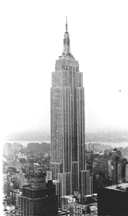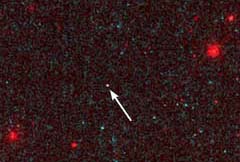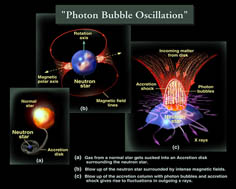RXTE Discoveries
Invasion of the Giant X-ray Bubbles - January 2000
by Christopher Wanjek
|
More bizarre news from the bizarre world of neutron stars: they have dozens of giant X-ray bubbles taller than the Empire State Building forming and popping every second. The group of scientists that predicted this exotic bubble phenomenon ten years ago is the same group that recently found the first evidence for it. And it took just about all they could muster: three whole days' worth of observational data and 1,200 hours of number-crunching on the slickest of supercomputers at the Lawrence Livermore National Laboratory. Mind you, these are the same powerful computers used to model nuclear reactions and calculate Bill Gates' salary. | 
|
 HST image of a lone neutron star |
Neutron stars are already known as the bad boys of the cosmic neighborhood. They are the core remains of larger, exploded stars, with a mass greater than our sun condensed into a sphere no bigger than Manhattan. A teaspoon of densely-packed matter from its surface, the analogy goes, would weigh three billion tons back on earth. Its 10 trillion gauss magnetic field could wipe your credit card clean at a distance half-way to the moon. Its intense gravity sucks gas away from nearby stars, which acts to spin the neutron star to speeds of up to a thousand times a second.
|
But giant X-ray bubbles dancing on the surface? That even freaked out the discoverers.
"Early on, I tended to disbelieve what the calculations were telling me," said Richard Klein, an adjunct professor of astronomy at UC Berkeley who also holds a position at Livermore. "The bubbles 'appeared' and I wasn't convinced they were real."
What Klein and one of his partners, Jonathan Arons, also a professor at UC Berkeley, were trying to visualize was the effect of streams of gas striking the neutron star with the force of a billion hydrogen bombs exploding every second every square yard in a region only a few miles wide. That had to be making some kind of dent, they thought. Arons tinkered with calculations on paper and pencil as early as 20 years ago; Klein began plugging equations into a supercomputer 10 years ago. Slowly, a concept called "photon bubble oscillations" emerged from the numbers. These would be caused by X-ray photons so intense that they push matter away to form a cavity before bursting in less than a millisecond. The problem was finding an instrument capable of observing such rapid flashes of high-energy action so deep in space.
Enter J. Garrett Jernigan, an X-ray astronomer up the road from Klein and Arons at Berkeley's Space Sciences Laboratory. He told his colleagues about a satellite that might be able to capture the bubbles: the Rossi X-ray Timing Explorer (RXTE), launched by NASA in 1995. The three scientists' attention then turned to a neutron star called Centaurus X-3, a tiny thing (in size, not in density!) only 13 miles in diameter and nearly 30,000 light years away.
Centaurus X-3 is not just any old neutron star; it is also an X-ray pulsar. This means that it is part of a binary star system and that it is bullying its companion star. Essentially, Centaurus X-3's extreme gravity steals blobs of gas from the companion star. This infalling matter, channeled by the intense magnetic fields onto the neutron star's polar caps, moves at one-third the speed of light and converts its energy into powerful X-ray radiation. We, on earth, see what seem to be pulses of X-rays from the polar regions as the neutron star spins -- every 4.8 seconds in the case of Centaurus X-3.
Jernigan thought Centaurus X-3 would be a good place to start the X-ray bubble hunt because the star is particularly bright in X-ray, it is strongly magnetized, and RXTE could get nice, long, steady observations of it.
 View Full-sized Diagram |
Sure enough, the scientists detected bubbles on Centaurus X-3. The X-ray bubbles, they said, are cavities of X-ray light in the sea of electrically charged gas, or plasma, on the neutron star surface. They appear only on the poles, a region about the size of midtown Manhattan. The sausage-shaped bubbles themselves rise up higher than the tallest of skyscrapers and wiggle, bob and burst in less than a New York minute -- about 2000th of a second, actually. The scene is like an ever-changing skyline of mile-high buildings.
|
Jernigan said that extreme gravity and radiation creates a strong pressure near the surface of the neutron star and pushes the infalling matter aside, poking holes in the matter and creating empty bubbles that fill with 100 million degree X-rays.
"The rain of hot matter and radiation onto the polar cap of the neutron star is like an extremely violent version of the Northern Lights," Jernigan said.
Klein described the bubbles as hot fingers of X-ray light rising up to a few miles above the surface of the neutron star only to fall and disintegrate, releasing their energy in a thousandth of a second. Klein said that X-ray bubbles form on the majority of neutron stars that are X-ray pulsars, of which there are scores in our galaxy alone. We likely have an entire universe of these bubble blowers.
If the bubble theory holds up, the Centaurus X-3 finding would mark the first time scientists have "seen" the surface of a neutron star -- and not the stream of matter falling into it from way above, stretching all the way back to the companion star.
Of course, no one has really seen the dancing bubbles nor the neutron star surface. These observations are in X-ray from a tiny speck of distant light. Data take the form of cycles of X-ray intensity. It is the scientist's job to determine where X-rays come from within this speck and what causes them. The X-ray bubble hunters concluded that variations in X-ray signals that they observed from the polar regions (which are actually a blending of the two indecipherable poles) are caused by surface physics and not by the physics of the flow of infalling matter. Jernigan himself, however, cautioned that this is a theoretical conclusion, not purely observational. Despite his carefully worded language to other scientists, there is disagreement.
"The idea of photon bubbles of very plausible," said Dr. Coleman Miller, an X-ray astronomer at the University of Maryland. "But the jury is still out on the results."
While Miller admitted that the models are good, he questions whether the data collected from Centaurus X-3 -- presented by Klein and Jernigan at an American Astronomical Society meeting -- truly give evidence of bubbles. Essentially, the bubble scientists are detecting oscillations so rapid and faint that artifacts in the X-ray detector itself might be able to give similar results. Scientists who work closely with RXTE suggested that the same experiment needs to be done on other stars to ensure that the bubbles are not merely ghosts in the machine. On the statistical side, they also wonder if the astronomers have collected enough data to truly test the model.
Klein defends his work in a paper soon to be published in Astrophysical Journal, in which he details a careful analysis of the data to show that the chance that the detector could be responsible for these results is extremely unlikely. He also plans to search for X-ray bubbles on other galactic neutron stars.
Jernigan will join Klein in his search, although he is not as optimistic, saying that a telescope 10-times greater that RXTE is needed to find the bubbles elsewhere. And no one is launching anything like that anytime soon. Two new X-ray satellites ringing in the golden era of X-ray astronomy -- Chandra and XMM -- will offer major advancements in angular and spectral resolution. None, however, will better RXTE's timing resolution, the kind of resolution needed to capture millisecond flashes of light.
For the three bubble hunters, Centaurus X-3 offers such a wonderful juxtaposition: blowing bubbles amidst nuclear hellfire. But for now, the only absolute confirmation of high-speed bubble action will be from a well-shaken can of soda pop.


